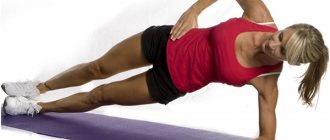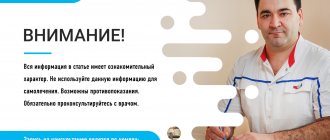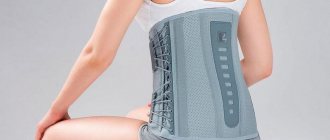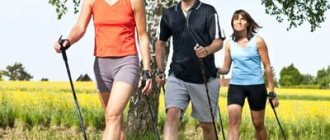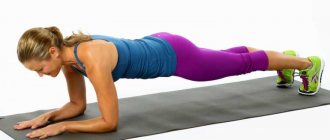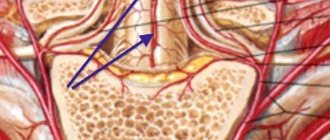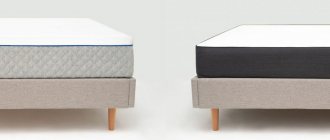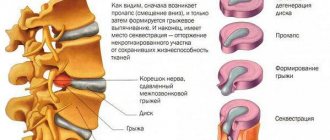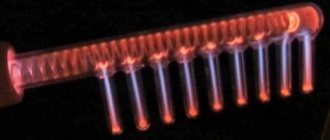Most adults periodically experience back pain, which worsens over time and signals serious diseases of the spine. Dosed physical activity is considered a universal means of preventing such problems: doctors strongly advise hanging on a horizontal bar, swimming or yoga.
However, with a hernia of the lumbar spine, incorrectly chosen exercises can provoke irreversible consequences. So is it worth training on the horizontal bar, and how exactly to build a workout?
where is the hernia located
Is it possible to exercise on the horizontal bar?
A pressing question for most patients: “Is it possible to hang and pull up on a horizontal bar with a diagnosis of intervertebral hernia?” Orthopedists recommend starting therapeutic exercises on the crossbar:
- after the exacerbation subsides,
- at all stages of remission,
- in the initial stages of pathology,
- during the recovery period after surgery.
Traction effectively maintains the duration of remission and allows you to stop the progression of the disease when localized in the cervical, thoracic and lumbar regions.
Orthopedic doctor, 12 years of work experience You can begin classes with the permission of the orthopedist, after an MRI and confirmation of the stage and size of the hernia.
For the exercises to be beneficial, you must follow the rules:
- classes are prohibited during painful attacks,
- start with small loads, gradually increasing them,
- train in natural, comfortable clothes,
- the appearance of pain is a reason to stop exercising,
- start exercising after warming up,
- movements are performed smoothly and accurately.
Muscles are different
The stronger the back muscles, the healthier the spine will be. This generally true statement is misunderstood by many. It is no coincidence that in fitness clubs and gyms there are so many men (and there are also women) who enthusiastically perform deadlifts and presses with heavy barbells. Neurologists note: if a person is too keen on such exercises, his back hurts no less, and in some cases, more than that of someone who does not go to strength training.
Article on the topic
Therapeutic yoga: 5 simple exercises for the back and lower back
Most barbell rows train the large muscles of the back. If they are strong, this is good - in everyday life a person will be able to lift heavy objects and carry bags with less risk of injury. However, the condition of the spine is affected not only by these muscles, but also by small muscles that are located deep. It is these deep muscles that allow us to hold our back upright when we stand or sit. Since most people sit a lot these days, the strength of these muscles is even more important than the larger ones. And during power loads they are practically not used. It turns out that a person who spends the vast majority of his time in the office and “lifts iron” in his leisure time does not in any way reduce the risk of spinal diseases.
And in some cases it even increases this danger. Lifting weights and the jerks that accompany rows dramatically increase the load on the back. If there are problems, this will lead to accelerated destruction of both the discs and joints of the spine.
How to?
If the initial stage of osteochondrosis or spondyloarthrosis is diagnosed, the back muscles should be trained using therapeutic exercises. It involves less intense movements than exercises in a rocking chair. But it is gymnastics that strengthens not just any specific groups of large muscles, but the muscular corset of the back as a whole. It also includes exercises for the abs, because the abdominal muscles also take on the load when we stand or sit, unloading the spine.
Your doctor may also allow you to go to the gym. However, these should not be strength exercises, when you lift a lot of weight, but endurance exercises - with light weights, but repeated repetitions.
Contraindications
Regular hanging for hernias will help to form correct posture and strengthen the paravertebral muscles. However, classes are contraindicated for the following problems:
- exacerbation of chronic diseases,
- sequestration,
- large hernia size,
- sharp pain in the back,
- problems with the vestibular system,
- attack of hypertension, heart rhythm disturbances,
- severe myopia,
- neurological disorders with coordination problems,
- increased intraocular pressure.
Briefly about the disease
Spinal discs suffer due to various factors. A hernia occurs under the following circumstances:
- if a person falls on his back or someone hits him hard;
- if the patient is obese;
- if the patient is diagnosed with spinal curvature;
- if osteochondrosis is detected;
- if there are regular heavy loads on the spine.
People at risk for intervertebral hernias are divided into several types. These are people who carry heavy loads every day, spend a long time driving a car and doing sedentary work.
The effect of pull-ups
Traction of the spinal column is an effective technique in the treatment of hernial protrusions. Properly selected and correctly performed exercises have a beneficial effect on intervertebral hernia. The effectiveness of the gymnastic apparatus is indisputable:
- strengthening the back muscles and abs,
- elimination of discomfort and unpleasant sensations,
- reducing pressure on the spine,
- relaxation and elimination of spasms,
- improved mobility, increased elasticity of connective tissue structures,
- normalization of blood flow and improvement of trophism,
- reducing the size of the hernia,
- healing of damaged vessels due to an increase in intervertebral space,
- activation of the removal of salts from osteochondral structures.
Exercises
Healthy pull-ups on the horizontal bar are performed after consultation with the orthopedist. Classes are carried out 1-2 times a day in 2 approaches. The duration of training for unprepared patients is no more than a minute.
The most effective techniques:
| Types of exercises | How to do it |
| Regular hang | The hands hold the bar, the body is relaxed |
| Listen to feelings | |
| Hanging movements | While hanging, additional elements are allowed: · bending the knees, · raising and lowering the legs with bent knees, · slight turns of the pelvis. More complex movements and loads are contraindicated |
| Hanging with pull-ups | Begins after 5-7 days of normal hanging |
| There should be no pain | |
| The first day perform 1-2 approaches | |
| The quantity is increased up to 7-8 times, more is undesirable | |
| Only do wide grip | |
| Alternating hang | Pull-ups become more difficult no sooner than after a week |
| Alternate grips - wide with narrow | |
| Reclining hang | The level of stretching is adjusted by tilting the bench |
| Partial support is done with feet on the floor |
The instructor selects a set of movements and load for each patient individually. The characteristics of the diagnosis, weight, training, and age are taken into account.
Orthopedic doctor, 12 years of experience During exercise, compression load on the spinal column should be completely eliminated. It is forbidden to jump up and down from the horizontal bar. To reach the crossbar, use a low bench, stool or step. Jerking and rocking are contraindicated.
A little trick that will help you avoid pain and hanging on the bar for half a minute - do not lift your socks off the floor and rest lightly on them. The crossbar is taken with 2 hands shoulder width apart. Before pulling up, inhale and hold your breath for a short time, exhale at the end of the exercise.
Let's pull and pull! Who can benefit from spinal traction?
When your back hurts, the natural desire is to hang on the horizontal bar.
How beneficial are tractions for the spine? In what cases can their use be justified, and when can they cause harm?
We talked about therapeutic traction with a neurologist and chiropractor at the Expert Voronezh Clinic, Candidate of Medical Sciences Viktor Fedorovich Opletaev.
— Back pain is always unpleasant. Modern doctors have enough methods in their arsenal to alleviate the condition of a patient with back diseases: from non-traumatic massage to radical surgery. In what cases is spinal traction prescribed?
The main indications for this procedure (otherwise known as spinal traction) are protrusions and small (up to 6 mm) herniated intervertebral discs; “unloading” of intervertebral discs and so-called facet joints; weakening or eliminating compression of nerve formations.
Read the material on the topic: How to treat hernias and protrusions of the spine?
In simple words, spinal traction is indicated for a patient who is in the gap between a healthy person and someone who already needs surgery.
— Victor Fedorovich, what types of spinal traction exist?
Conventionally, according to the method of execution, it is divided into “dry” and underwater (the definitions speak for themselves); simple mechanical (using weights) and hardware (using a computer and traction system). The latter happens in combination with massage and without it.
— How is the healing effect achieved during spinal traction?
During the procedure, the perivertebral ligaments and muscles are stretched. The pressure inside the intervertebral disc decreases. Conditions are created to eliminate subluxations of the intervertebral joints, reduce or relieve compression (pressure) of the spinal nerves and feeding blood vessels passing here. The latter fact helps to improve microcirculation, reduce venous stagnation and swelling of the spinal roots.
Read the material on the topic: Does osteochondrosis exist?
— Tell us more about hardware spinal traction. How is this procedure carried out?
The procedure is performed in a lying position on a special table (couch). The patient is put on two belts - one above and the other below the traction site. These belts are fixed, respectively, to the head and foot ends of the bed. When stretching the neck, a so-called Glisson loop is put on the head (traction is done with its help), the lower part of the body is not fixed.
Using a computer program, the traction mode and its parameters are selected (load, with or without massage, etc.) and traction begins. It is fully automated and performed exactly according to the specified parameters.
After the procedure is completed, it is necessary to wear a corset (on the thoracic and thoracolumbar regions) or a special Shants collar (on the neck) for some time (1-2 hours). This is done to prevent sudden “shrinkage” of the discs after traction.
In the future, it is advisable to engage in physical therapy to strengthen the muscles surrounding the spine.
— How many sessions does a patient need to undergo to achieve a therapeutic effect?
Optimally - from 10 to 20, depending on the dynamics of positive changes. On average, the patient begins to feel the effect after 5-7 sessions. Sometimes after 1-2 sessions there may be a certain deterioration. If it is insignificant, according to the doctor’s decision, the course of traction can be continued. Otherwise, the procedure is not carried out further.
Read the material on the topic: Who will benefit from MRI of the spine?
— When is hardware spinal traction contraindicated?
As with any physiotherapeutic procedure, contraindications include cancer; exacerbation of chronic pathologies, inflammatory processes of the pelvic organs and abdominal cavity; intervertebral hernia more than 6 mm (relative contraindication, the possibility of carrying out the procedure is decided depending on the specific situation); so-called sequestered hernias (when a fragment of the disc is separated from its main mass), osteoporosis, old age.
Read the material on the topic: How is manual therapy useful?
— Under what conditions can spinal traction cause harm to a patient suffering from back pain?
This is possible if the above contraindications are ignored; when the procedure is performed without an MRI examination and there is no accurate diagnosis.
— Is it true that spinal traction provokes hernia formation and leads to the formation of new protrusions?
No, quite the opposite, since the mechanism of action on the discs is aimed precisely at reducing the conditions for the formation of protrusions and hernias.
Read more materials about health, methods of diagnosis and treatment of various diseases on our social networks: VKontakte, Facebook, Odnoklassniki
— In order to undergo spinal traction, do you need a doctor’s referral?
Absolutely yes. This procedure is carried out on the direction of a neurologist, orthopedist-traumatologist or neurosurgeon, since only a specialized specialist can objectively assess the indications, contraindications and predict the development of possible complications.
Read the material on the topic: Educational program on medical professions. When to contact a neurologist?
— Spinal traction is indicated only for the treatment of diseases of the spinal column or can it be recommended for prevention?
In a certain sense, we can talk about prevention. For example, a person may have osteochondrosis, which is even accompanied by pain (particularly due to muscles), but there are no hernias or protrusions (yet). In this case, traction can be considered as a method of preventing pathological structural changes in the intervertebral discs.
— Viktor Fedorovich, what diagnostics does a patient need to undergo before spinal traction sessions?
It is mandatory to perform an MRI of the spine and, if indicated, electroneuromyography.
You can sign up for an MRI of the spine here
— What should a patient be wary of during a spinal traction procedure? How to understand that his health is in the reliable hands of a professional?
It is important to focus on the appearance of pain: normally the procedure is painless.
You will be told more about spinal traction during your consultation.
You can make an appointment by phone in the contacts section
Please note: the service is not available in all cities
Other
Preparation
It is recommended to exercise 2 times a day - morning and evening. It is necessary to start exercising on the crossbar after a light warm-up and warm-up. To do this, perform joint gymnastics for 3-5 minutes. They stretch their backs, perform turns and raise their arms. A simple warm-up includes exercises such as:
- rotation of the arms in the shoulder joints,
- throwing back and tilting the head,
- moving the shoulders back.
Orthopedic doctor, 12 years of experience. You should always start the exercises with a normal hang for 30 seconds.
The horizontal bar for the treatment of intervertebral hernia is used quite often, the exercises are coordinated with the doctor. The correct approach to gymnastics on the horizontal bar accelerates the onset of remission and prevents the development of complications. Even against the backdrop of excellent performance, you should exercise regularly, adhering to the principles of phasing. Heavy loads can provoke an exacerbation and worsen the course.
Exercises for hernia
The horizontal bar is indicated if the disease is moderate : the hernia is small and the nerve nodes are not compressed by it. But if there are many hernias and they are large, then it is better not to risk it. You can’t even just hang from a bar without a doctor’s permission.
Exercises on the horizontal bar are contraindicated for patients whose pathology is clearly expressed and has been going on for more than one year.
The main contraindications can be identified:
- The presence of severe pain, which indicates an advanced stage of the disease.
- Inflammatory processes are observed in the spine. Loads will cause them to increase, so this condition is eliminated first.
- Sequestration, that is, the last stage of intervertebral hernia. In this case, any physical activity is prohibited.
- Exercises on the crossbar are prohibited during the period of exacerbation of the hernia, which lasts about 4 days.
Exercising on the horizontal bar is contraindicated for large and sequestered hernias
It is difficult to assess the advisability of training on the horizontal bar on your own; consultation with a doctor is necessary.
There are also prohibited exercises for spinal hernia:
- Axial or rotational loads should not be allowed, that is, twisting on the horizontal bar should be avoided.
- Under no circumstances should you perform complex elements (different “exits” or “sun”). They are generally unacceptable to do in case of spinal disease, not only in case of protrusion or hernia.
- Any fast exercises with sudden movements are prohibited.
A hernia is usually a complication of osteochondrosis, and with this pathology you need to stretch it very carefully. Having decided to exercise on the horizontal bar yourself, you should strictly control the load, otherwise problems will arise.
The following nuances must be taken into account:
- If you have a thoracic hernia, it is better not to train on your own; you need medical supervision.
- With a cervical hernia, dizziness and frequent headaches may occur.
- In people with a lumbar hernia, self-training can increase the stimulation of hernia formation by almost 1.5 times.
This should not be forgotten if training takes place without the supervision of a specialist.
Video: “Benefits and harms of spinal traction”

